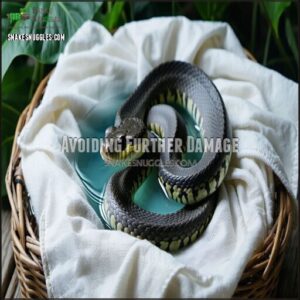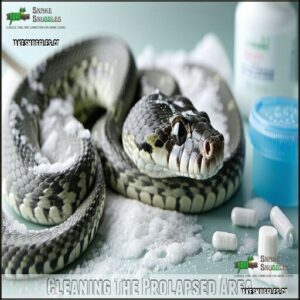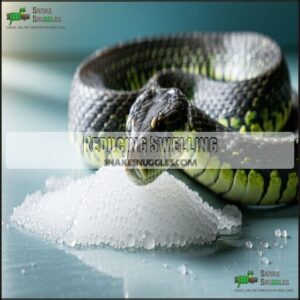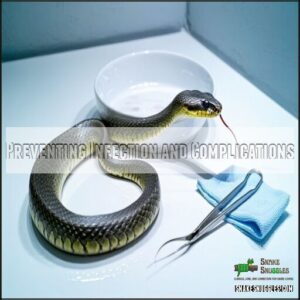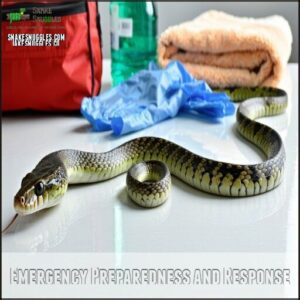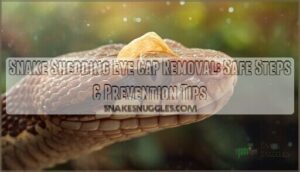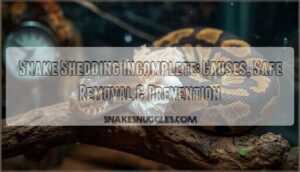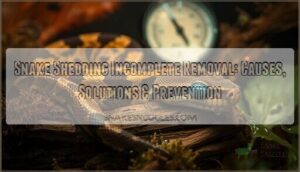This site is supported by our readers. We may earn a commission, at no cost to you, if you purchase through links.
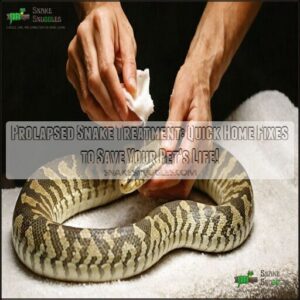
Immediately keep the exposed tissue moist by gently applying a sugar water solution, which helps reduce swelling and prevent tissue damage. Minimize handling to avoid further trauma, and create a warm, humid environment to support healing.
Carefully clean the prolapsed area with a sterile saline solution, but don’t attempt to push the tissue back inside. Your primary goal is preventing infection and maintaining tissue integrity.
While home treatment can provide initial care, a veterinary consultation is essential for a thorough treatment plan. Quick, careful action could make all the difference in your snake’s recovery.
Table Of Contents
- Key Takeaways
- Snake Prolapse Causes
- Immediate Care Steps
- Home Treatment Options
- Preventing Infection and Complications
- Species-Specific Considerations
- Reducing Stress and Promoting Healing
- Signs of Improvement and Recovery
- Common Mistakes to Avoid
- Long-Term Care and Prevention
- Emergency Preparedness and Response
- Frequently Asked Questions (FAQs)
- How to help a snake with prolapse?
- How do you fix a reptile prolapse?
- Why does my ball python keep prolapsing?
- What is a prolapsed Hemipenes in snakes?
- Can I use hydrogen peroxide for cleaning?
- How expensive is snake prolapse treatment?
- What if my snake stops eating completely?
- Can reptile prolapses happen during snake breeding?
- Is snake prolapse always life-threatening condition?
- Conclusion
Key Takeaways
- You’ll need to act fast if your snake has a prolapse by keeping the exposed tissue moist with a sugar water solution or lukewarm water, preventing tissue damage and reducing swelling.
- Don’t attempt to push the prolapsed tissue back inside yourself; instead, minimize handling, create a warm and humid environment, and seek immediate veterinary consultation.
- Watch for critical signs of infection like redness, heat, or discharge around the prolapsed area, and monitor tissue color and swelling regularly to prevent serious complications.
- Your snake’s recovery depends on maintaining proper husbandry, providing gentle care, ensuring adequate nutrition and hydration, and preventing stress during the healing process.
Snake Prolapse Causes
If you’ve noticed your snake’s internal tissues protruding from its cloaca, you’re facing a serious medical emergency that demands immediate attention.
Understanding the root causes of snake prolapse can help you recognize warning signs early and potentially prevent this distressing condition from developing or worsening.
Constipation and Diarrhea
Constipation and diarrhea can wreak havoc on your snake’s digestive system, potentially triggering dangerous prolapse.
These gut health challenges often stem from poor diet, dehydration, or inadequate fiber intake.
Stool softeners and proper hydration help regulate bowel movements, reducing strain during defecation.
Understanding and addressing these digestive issues is essential for preventing reptile prolapse and maintaining your snake’s overall wellness.
Gastrointestinal Parasites
When parasites wreak havoc in your snake’s gut, they’re not just unwelcome guests—they’re potential prolapse triggers.
Here’s how intestinal infections can set the stage for serious health complications:
- Cause inflammation and excessive straining
- Weaken intestinal muscle integrity
- Create digestive system disruptions
- Increase cloacal tissue vulnerability
- Compromise overall reptile health
These gut invaders can turn your snake’s internal ecosystem into a breeding ground for dangerous prolapse conditions.
Stay vigilant!
Egg Binding
How often do female snakes struggle with egg binding during breeding seasons?
This reproductive complication can trigger severe strain, forcing excessive pushing that leads to dangerous cloacal prolapse.
Female snakes experiencing oviposition disorders may develop significant reproductive issues, causing intense physical stress.
Proper veterinary intervention becomes critical when egg retention threatens your snake’s health and survival, making it essential for proper veterinary intervention.
Metabolic Bone Disease
After battling egg binding, your snake might face another serious health challenge: Metabolic Bone Disease (MBD). This condition weakens your pet’s skeletal structure through calcium deficiency, setting the stage for potential prolapse complications.
Your reptile’s health hinges on understanding these critical dietary and mineral dynamics that underpin snake prolapse treatment.
- Calcium levels plummet, causing fragile bones
- Vitamin D3 absorption becomes compromised
- Mineral imbalances trigger systemic breakdown
- Bone deformities emerge, reducing structural integrity
The key to addressing this issue lies in recognizing the critical dietary aspects and the impact of mineral dynamics on your snake’s health.
Immediate Care Steps
When your snake experiences a prolapse, you’ll need to act fast to prevent tissue damage and infection.
Keep the exposed area moist with clean, lukewarm water and minimize handling to give your slithery friend the best chance at recovery.
Keeping Tissue Moist
In the critical moments of a snake prolapse, moisture can mean the difference between life and death.
Keep the exposed tissue hydrated using clean, lukewarm water or a gentle sugar solution.
Carefully wrap the prolapsed area with a soft, damp cloth to prevent drying and maintain critical tissue moisture levels during this delicate reptile prolapse treatment.
Avoiding Further Damage
After keeping your snake’s prolapsed tissue moist, you’ll want to prevent further damage.
Never attempt to push the tissue back inside, as this can cause severe trauma.
Protect the delicate area from additional injury by creating a soft, barrier-free environment.
Your gentle approach and careful tissue protection are key to minimizing complications during this critical snake home treatment, ensuring a successful outcome with minimal complications.
Minimizing Handling
After preventing further tissue damage, your next move is minimizing handling to protect your snake’s delicate condition.
Snake prolapse treatment demands gentle restraint and strategic care.
Handling tips for your prolapsed snake:
- Use soft, clean cloth for minimal contact
- Support snake’s body without pressure
- Limit movement to reduce stress
Reduced handling prevents additional trauma, supporting your snake’s fragile recovery process.
Home Treatment Options
When your snake experiences a prolapse, you’ll need to act quickly to prevent further tissue damage and potential infection.
Your immediate home treatment can make a critical difference in your pet’s recovery, so it’s vital to follow precise steps for cleaning, reducing swelling, and keeping the affected area moist.
Cleaning The Prolapsed Area
When your snake experiences a prolapsed area, cleanliness becomes your top priority.
Wrap the exposed tissue gently in a clean, soft, moist cloth to protect it from further damage. Watch closely for any signs of redness or swelling.
Handle the snake minimally during this delicate process, focusing on gentle wound cleaning with warm water and mild antiseptic to prevent potential infections.
It’s essential to address the issue promptly to prevent complications related to reptile health issues.
Applying Sugar Solution
After cleaning the wound, you’ll want to master sugar solution application for your prolapsed snake.
Here’s how to prepare and apply this life-saving treatment:
- Quick relief for desperate moments
- Gentle healing at home
- Professional-grade intervention
- Stress-reducing technique
Mix one tablespoon of sugar per three ounces of water.
Soak the snake for 40 minutes, using a Vaseline-coated cotton swab to assist retraction without direct pressure.
The sugar solution draws fluid from tissue, reducing swelling and preventing further damage.
Understanding the proper sugar solution properties is essential for effective treatment.
Reducing Swelling
A gentle sugar solution works wonders for tissue swelling reduction in cloacal prolapse.
Apply cold compresses and moist wraps to minimize inflammation. Use soft, gentle pressure when handling the affected area.
Anti-inflammatory techniques like these help reduce tissue damage and promote healing.
Carefully monitor your snake’s condition, keeping the prolapsed tissue protected and hydrated.
Preventing Infection and Complications
When your snake experiences a prolapse, preventing infection becomes your top priority to guarantee a successful recovery.
You’ll need to act quickly, maintain a sterile environment, and closely monitor the affected area for any signs of bacterial growth or tissue damage.
Antibiotics and Antiseptics
Something might creep up silently with snake prolapse: dangerous bacterial infections.
Veterinarians typically prescribe oral antibiotics for a 10-day course, targeting potential wound complications.
Warm saline and antibacterial soaps serve as emergency antiseptic treatments when professional help isn’t immediately available.
Nonsteroidal anti-inflammatory drugs can help manage swollen tissue during critical treatment stages.
Effective antibiotic snake treatment requires careful consideration of antibiotic options, which is a critical treatment stage that involves managing swollen tissue.
Maintaining a Clean Environment
In the wake of a snake prolapse, your reptile’s terrarium becomes a critical healing sanctuary.
Implement rigorous Sanitation Protocols by replacing substrate with clean, fresh paper towels to minimize infection risks.
Maintain proper humidity levels and verify your reptile home remedies include frequent, thorough cleaning of the enclosure to support your snake’s delicate recovery process and ensure a safe environment with proper humidity levels.
Monitoring for Signs of Infection
After maintaining a spotless enclosure, your next defense against reptile health issues is vigilant infection monitoring.
Watch for redness, heat, or discharge around the prolapsed area. Check tissue color and swelling regularly.
Bacterial infection risk increases with prolonged exposure, so track healing process scrupulously.
Any unusual changes demand immediate veterinary attention to prevent serious complications.
Species-Specific Considerations
Your snake’s species dramatically impacts prolapse treatment, so you’ll need to understand its unique physiological characteristics and vulnerabilities.
Knowing your snake’s unique traits is key to providing precise, life-saving prolapse treatment.
Each reptile species requires customized care strategies that address specific anatomical differences and potential underlying health challenges.
Ball Pythons and Dehydration
After preventing infection, you’ll want to zero in on ball python hydration—a game-changer for snake prolapse treatment.
Dehydration weakens tissues, increasing prolapse risks.
Keep humidity levels between 70%-80% and offer daily lukewarm water soaks. A humidity box with damp towels provides stress-free hydration.
When in doubt, consult a vet for advanced ball python health interventions.
Bearded Dragons and Parasites
After exploring ball python hydration challenges, let’s tackle a slippery problem for bearded dragon owners: parasites. These microscopic invaders can wreak havoc on your reptile’s health.
Parasite Control is critical for Dragon Health. By staying vigilant, you’ll protect your scaly friend.
Here are some key points to consider:
- 67% of dragons carry significant parasite loads
- Fecal transmission is the primary infection route
- Watch for weight loss and behavioral changes
- Annual veterinary screenings prevent major health risks, which is essential for maintaining good health.
Turtles and Gastrointestinal Issues
In the murky waters of turtle digestive health, gastrointestinal issues can trigger dangerous prolapses.
Understanding their unique challenges is essential for reptile owners.
| Issue | Impact |
|---|---|
| Poor Turtle Diets | Weakens Gut Health |
| Digestive Enzyme Imbalance | Increases Prolapse Risk |
| Inadequate Shell Care | Compromises Immune System |
| Stomach Irritation | Triggers Tissue Stress |
| Nutritional Deficiencies | Disrupts Digestive Function |
Proactive care prevents potential life-threatening complications in these delicate reptilian companions, and addressing these issues is crucial for maintaining gut health and preventing prolapse risk.
Reducing Stress and Promoting Healing
When your snake experiences a prolapse, you’ll need to create a calm, nurturing environment that supports healing and reduces additional stress.
By minimizing handling, maintaining ideal temperature and humidity, and providing gentle care, you’ll help your snake recover and increase its chances of a successful treatment.
Providing a Warm and Humid Environment
Your snake’s healing journey hinges on creating Humid Hideouts with precise Temperature Control.
Warm Lighting and carefully managed heat sources become your recovery allies. Aim for a reptile terrarium mimicking natural, Moist Environments—around 85-90°F with 60-70% humidity.
This gentle, regulated heat helps reduce stress and supports tissue healing without overwhelming your vulnerable patient.
Effective reptile heat management is vital for maintaining ideal temperatures, which is crucial for a successful recovery and creating a comfortable environment.
Minimizing Handling and Agitation
Your delicate friend needs a calm, quiet space during snake prolapse treatment.
Gentle handling is essential—touch minimally and keep interactions brief to reduce stress.
Create a peaceful environment away from loud noises and other pets.
A soft, clean towel and minimal disturbance can help your reptile heal, preventing further tissue damage and supporting its recovery.
A calm environment is crucial for the healing process, and by following these steps, you can help your reptile heal quickly and minimally.
Ensuring Proper Nutrition and Hydration
After minimizing handling, your focus shifts to nutrition and hydration.
A balanced diet is key to healing a prolapsed snake.
Offer small, easily digestible meals and plenty of fresh water.
Consider nutrient supplements recommended by your vet.
Keep the snake warm and hydrated, using sugar water baths sparingly.
Patience and careful feeding support natural reptile health care during recovery.
It’s vital to understand the importance of proper rectal prolapse care to guarantee a successful recovery.
Signs of Improvement and Recovery
You’ll want to closely monitor your snake’s recovery, looking for key signs that indicate healing and improvement.
Watch for reduced swelling, increased appetite, and gradual tissue reinsertion, which signal your pet’s positive response to treatment and potential return to health, indicating a positive response.
Monitoring for Reduced Swelling
As you tend to your snake’s delicate recovery, monitoring swelling becomes your lifeline. A sugar water soak can draw fluids and encourage tissue retraction, giving hope during this critical healing stage.
- Your vigilance is the snake’s best medicine
- Each gentle observation brings healing closer
- Small changes reveal big recovery signals
- Hope thrives in careful, compassionate care
Watch for tissue color shifts, size variations, and fluid discharge—key indicators of your snake’s progress in prolapsed snake care. Monitoring these signs with vigilance is essential for a successful recovery.
Observing Improved Appetite and Activity
As swelling starts to subside, your snake’s appetite and activity levels become key indicators of recovery.
Watch for subtle signs of improvement in their behavior and energy.
Here’s a quick guide to tracking your reptile’s healing journey:
| Recovery Indicator | Positive Sign | Caution Sign |
|---|---|---|
| Appetite | Willingly accepting small meals | Refusing food completely |
| Movement | Exploring enclosure gently | Remaining motionless |
| Behavior | Alert and responsive | Lethargic or withdrawn |
Gradual improvements signal successful snake prolapse treatment and potential return to health.
Noticing Tissue Reinsertion
After identifying potential tissue reinsertion, watch for key signs of snake prolapse healing. Your careful observation can signal recovery progress through these critical markers:
- Gentle tissue retraction
- Reduced tissue discoloration
- Minimal protrusion length
- Smooth tissue texture
Expert snake prolapse treatment demands patience. Tissue healing requires precise monitoring, ensuring your reptile companion returns to ideal health with precise, attentive care during this delicate recovery phase.
Common Mistakes to Avoid
When treating a prolapsed snake at home, you’ve got to avoid making critical errors that could worsen your pet’s condition.
Your quick actions and careful handling can mean the difference between successful recovery and potentially life-threatening complications.
Pushing Tissue Back In
As you monitor your snake’s tissue reinsertion progress, resist the urge to manually push the prolapsed area back in.
Applying gentle pressure can cause severe tissue damage during snake prolapse treatment.
Instead, use moist wrapping techniques and sugar solutions recommended by reptile experts.
Professional veterinary intervention remains the safest approach for prolapse treatment and tissue support.
Excessive Handling and Agitation
A snake’s delicate prolapse demands your gentlest handling techniques to prevent further injury and stress.
Minimize contact with your reptilian friend during this critical healing period.
Consider these essential agitation prevention steps:
- Limit physical interactions
- Create a calm environment
- Reduce sudden movements
- Maintain quiet surroundings.
Gentle care is your snake’s best medicine, protecting vulnerable tissue from additional trauma during the sensitive recovery process.
Understanding proper handling techniques is essential for reducing stress and promoting a safe environment, as seen in resources like handling techniques, which can guide you through the process of caring for your snake during its recovery.
Ignoring Signs of Infection or Complications
Ignoring warning signs of infection can turn a treatable snake prolapse into a life-threatening emergency.
Recognizing early complications means the difference between recovery and potential loss.
Here’s a quick reference for critical infection markers:
| Symptom | Urgency Level |
|---|---|
| Discoloration | High |
| Foul Odor | Critical |
| Excessive Swelling | Immediate Action |
| Discharge | Urgent |
| Tissue Necrosis | Emergency |
Don’t gamble with your reptile’s health—act fast to address these critical issues.
Long-Term Care and Prevention
Your snake’s recovery from prolapse doesn’t end with initial treatment, and you’ll need an exhaustive strategy to prevent future incidents.
By implementing consistent veterinary monitoring, maintaining ideal husbandry conditions, and addressing underlying health factors, you can substantially reduce the risk of recurrence and support your snake’s long-term wellness.
Regular Veterinary Check-Ups
After avoiding common mishaps, your next defense against snake prolapse is scheduling annual veterinary check-ups.
Regular health exams catch potential issues before they escalate, which can protect your slithery friend’s longevity.
- Catch hidden health problems early
- Save money on future treatments
- Prevent potential life-threatening complications
- Build a trusted relationship with reptile experts
Yearly visits by experienced reptile veterinarians provide thorough snake health assessments, ensuring your pet stays in top condition and receives the best care to prevent potential life-threatening complications.
By following this approach, you can save money on future treatments and ensure your snake receives the care it needs to thrive.
Maintaining Proper Husbandry and Nutrition
After your vet checkup, focus on rock-solid husbandry.
Your snake’s nutrient balance and humid environment are its lifeline. Optimize enclosure size, maintain pristine water quality, and tailor dietary needs precisely.
Reptile husbandry isn’t rocket science—it’s about creating a stable, stress-free home that prevents future snake health problems and potential prolapse recurrence.
Monitoring for Signs of Recurrence
After treating a snake’s prolapse, vigilant monitoring becomes your lifeline for preventing future complications.
Keep a keen eye on your reptilian friend’s recovery with these critical checkpoints:
- Track tissue healing and color normalization
- Watch for recurring swelling or inflammation
- Note changes in bathroom habits and appetite
- Observe overall energy levels and movement patterns
Consistent post-treatment care can mean the difference between full recovery and potential recurrence.
Proper snake care involves understanding skin health basics to prevent infections and promote healing.
Emergency Preparedness and Response
When your snake experiences a prolapse, you’ll need to act fast to prevent serious complications and potential tissue damage.
Your quick response and preparedness can make the difference between a successful recovery and a life-threatening situation for your reptilian companion.
Identifying Emergency Veterinarians
When your snake faces a critical health crisis, knowing how to quickly locate emergency veterinary care could mean the difference between life and death.
Search for reptile specialists who offer urgent care by consulting local vet clinics, checking online reviews, and networking with snake owners.
Research emergency vet locations that handle reptile patients and understand their specialized snake veterinary care services, which is vital for making informed decisions during a crisis and requires understanding of emergency snake care.
Keeping Contact Information Handy
Within moments of a snake prolapse, having critical contact information at your fingertips can be a lifesaver.
Keep these essential contacts ready:
- Reptile-savvy emergency veterinarian
- Local breeder or snake specialist
- Trusted snake owner networks
- Reptile emergency care hotline
Proactive preparation guarantees swift action during unexpected pet health crises, transforming potential panic into confident, immediate response for your snake’s survival.
Familiarizing Yourself With Basic First Aid Techniques
After jotting down your vet’s contact info, it’s time to master pet snake first aid.
Learn basic wound care techniques for snake injury repair. Practice gentle handling methods, understand prolapse symptoms, and know how to temporarily stabilize your reptile.
Familiarize yourself with emergency response protocols, focusing on wound treatment and basic hygiene to minimize potential complications during a critical moment.
Frequently Asked Questions (FAQs)
How to help a snake with prolapse?
Keep the prolapsed tissue moist with lukewarm water or sugar solution.
Don’t push it back. Contact a reptile vet immediately.
Wrap the area gently in a clean, damp cloth. Minimize handling and stress while awaiting professional treatment.
How do you fix a reptile prolapse?
When your reptile’s insides decide to take an unexpected vacation, don’t panic.
Gently clean the prolapsed tissue with lukewarm water, keep it moist.
Rush to a specialized vet for immediate, professional treatment.
Why does my ball python keep prolapsing?
Your ball python might be prolapsing due to underlying health issues like parasites, poor husbandry, dietary imbalances, or metabolic problems.
Consult a reptile vet to identify the root cause and develop a targeted treatment plan.
What is a prolapsed Hemipenes in snakes?
When your male snake’s reproductive organs slip outside the body, you’ll see a hemipene prolapse—a painful condition where internal tissues protrude through the cloaca.
Often, this condition requires immediate veterinary intervention to prevent permanent damage.
Can I use hydrogen peroxide for cleaning?
By sheer coincidence, hydrogen peroxide isn’t recommended for cleaning a snake’s prolapsed tissue.
You’ll want to use warm water and a mild antiseptic instead, as peroxide can damage delicate healing tissues and cause further complications.
How expensive is snake prolapse treatment?
You’ll likely spend $200-$800 for veterinary treatment, depending on your location, the snake’s condition, and required procedures.
Emergency care and surgical interventions can quickly increase costs, so pet insurance might help manage expenses.
What if my snake stops eating completely?
If your snake stops eating, it’s a serious sign.
Monitor its behavior, check environmental conditions, and consult a reptile vet immediately.
Reduced appetite could indicate stress, illness, or underlying health issues requiring professional evaluation.
Can reptile prolapses happen during snake breeding?
Breeding stress, physical strain, and reproductive challenges can trigger prolapses.
You’ll want to monitor your reptiles closely during mating, ensuring gentle handling and watching for signs of potential tissue displacement or injury, which can be a result of reproductive challenges.
Is snake prolapse always life-threatening condition?
While not always fatal, a prolapse demands immediate veterinary attention.
Without prompt treatment, you’ll risk tissue damage, infection, and potential organ loss.
Your quick response can substantially improve your snake’s chances of recovery.
Conclusion
Like a tightrope walker balancing between crisis and care, your swift response to prolapsed snake treatment at home can mean the difference between life and death.
Don’t panic, but act decisively, and keep the tissue moist, minimize handling, and clean gently.
While home remedies provide critical first aid, a veterinarian’s expertise is essential for a successful healing journey, and your attentiveness and quick, careful actions can help your snake recover.
Turning a potentially fatal situation into a successful healing journey can be achieved with the right care and attention.
- https://veterinarypartner.vin.com/default.aspx?pid=19239&catId=253992&id=7996764
- http://blogs.thatpetplace.com/thatreptileblog/2008/08/14/amphibian-and-reptile-emergencies-prolapsed-cloaca/
- https://www.reddit.com/r/ballpython/comments/fykt7u/snake_prolapse_cant_afford_vet_what_should_i_do/
- https://bamboozoo.weebly.com/snake-health-rectal-prolapse.html
- https://reptilesmagazine.com/reptile-cloacal-prolapse-2/?srsltid=AfmBOopfOC5ICBKLMlTbzzxo8hoxExKuiRF8JEGG0S_uu8StmY2Lz-i2



